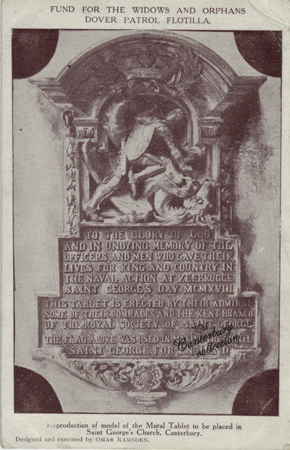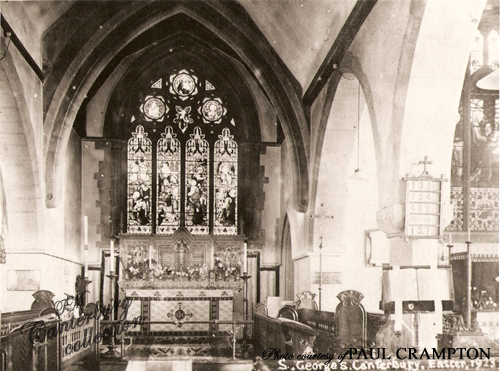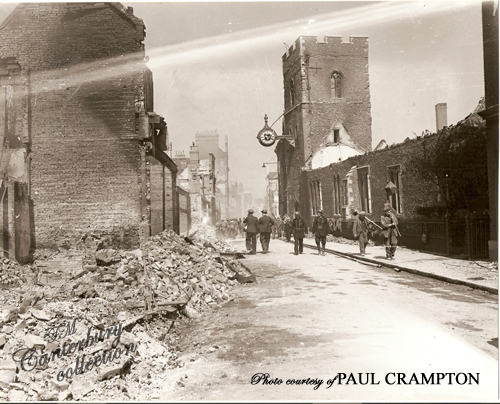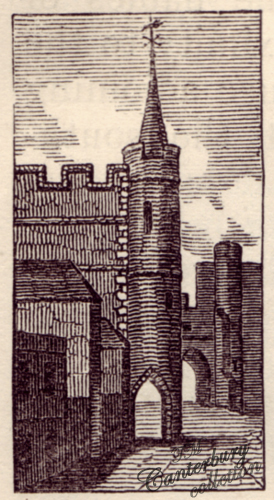
![]()
~ ST. GEORGE THE MARTYR ~
THE CHURCH OF ST. GEORGE THE MARTYR
ST. GEORGE'S STREET, CANTERBURY
Enlargement of church 1870-1872 by Charles N. Beazley
Destroyed in the bombing June 1, 1942, only the clock tower remains
St. George Parish Records available at the Canterbury Cathedral Archives (1538 -1945)
The registers of St. George the Martyr date from 1538, the portion between that date and 1574 being a copy from a pre-existing book.
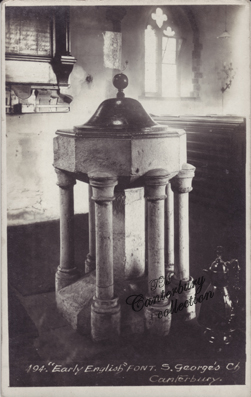
St. George's Font c. 1900, from my collection
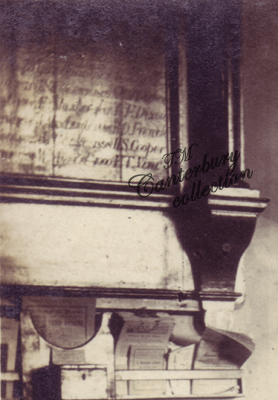
Detail from St. George's Font, c. 1900 - showing the Rev'ds...Dixon, French, Cooper, Vine
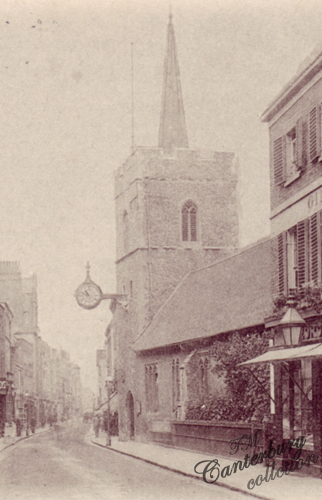 _____
_____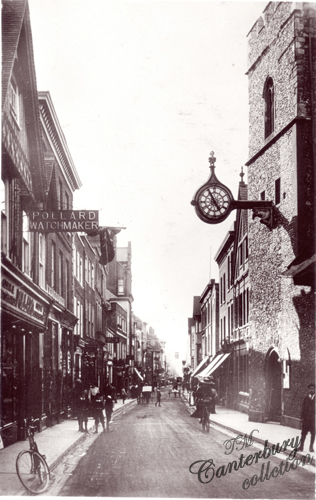
Postcards of St. George's street from my collection
Christopher Marlowe was baptised here in 1564
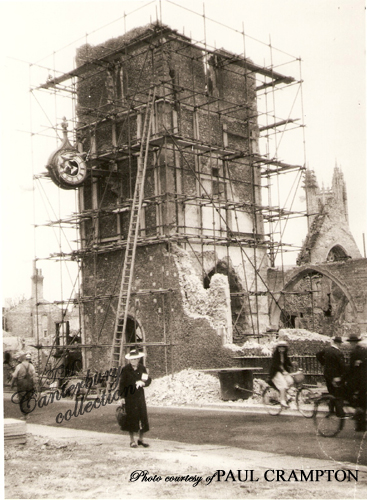
A view of a month later, on 2nd July 1942, and you can see just how much of the fabric had been lost before the attempt to demolish the church (mid June) was halted by the intervention of Canon Crum.
write-up and photo courtesy of Paul Crampton www.paulcramptonbooks.co.uk/
A postcard in my collection - Fund for the widows and orphans Dover Patrol Flotilla
Pre-production of model of the Mural Tablet to be placed in Saint George's Church, Canterbury - designed and executed by Omar Ramsden
The other very special thing about this card is it was sent to Pte. W. M. Skelton Ham W Wellington, Somerset from Vice Admiral Sir Roger Keyes
"In remembrance of St. George's Day 1918. Hope you are getting on all right. With all good wishes from Vice Adm. Sir Roger & Lady Keyes. Fleet House Dover."
1639 Dec 9, marriage of Abraham TERRY and Alice RUCKE
1709, Feb 12, christening, St. George, Canterbury, John son of Thomas TERRY
1728 August 11, burial, St. George, Canterbury. Widow TERRY from St. Pauls. p.
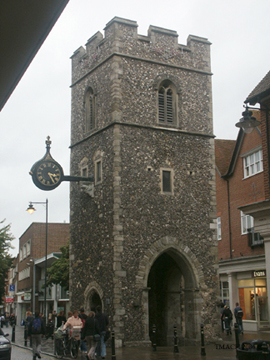 _____
_____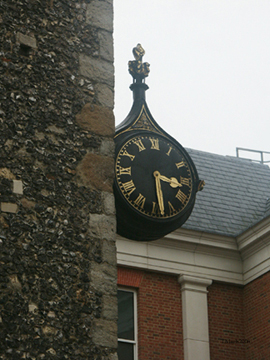
St. George's Tower and Clock, my 2006 photo's above
The clock face was made by William Biggleston and the bracket was made by Herbert Biggleston c. 1906
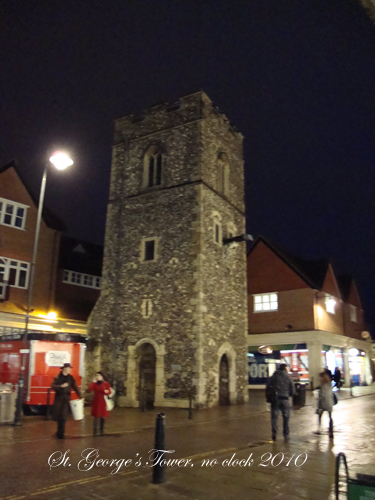 ____
____
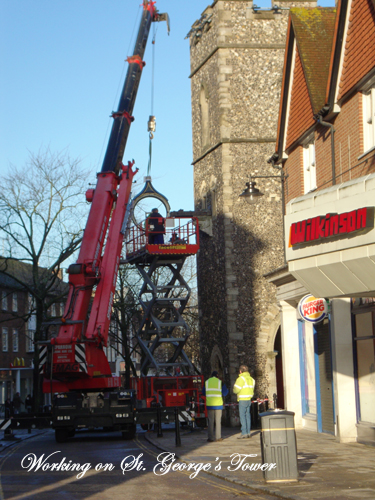
St. George's Tower, the clock has been removed to renew the face & putting the clock back 2010
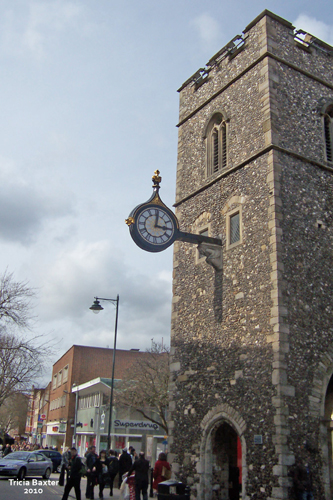 |
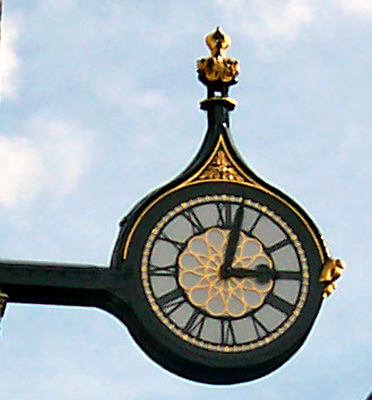 |
___St. George's Tower 2010, with new clock face, thanks to Tricia for these
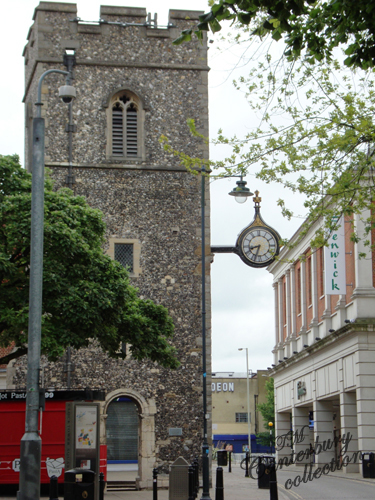
December 1795 - December 22nd, marriage at St. George's, Canterbury, Mr. Edward Philpot, saddler, to Miss Palmer, daughter of Mr. John Palmer, taylor and draper. KR
"Brazen-Nose College. Founded in 1509"...eight fellowships have been since added; two by the will of John WILLIAMSON, Rector of St. George's, Canterbury in 1522, which are confined to his kindred...."
Quarter Sessions - William Stokys for burning timber which covered a well belonging to the church of Canterbury St. George with the result that a cow fell in and was drowned. CC/JQ/322/iii 1523
1586. An annual stipend of 1l. 6s. 8d. is paid to a person, who shall every morning, at four o'clock, ring the great bell, in Saint George's steeple, for one quarter of an hour. HT
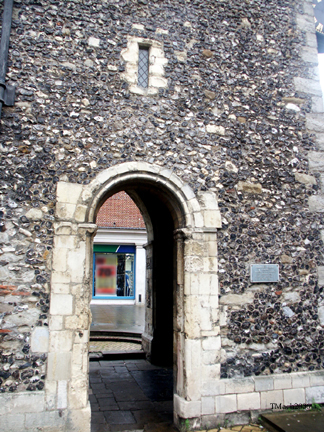 _____
_____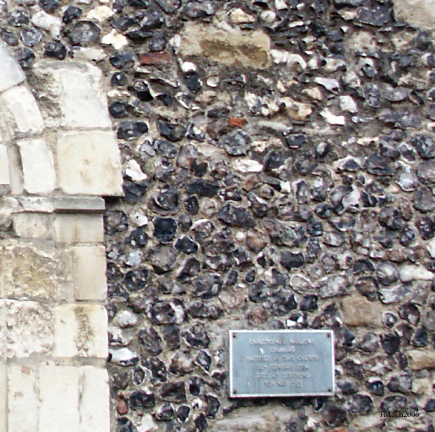
My 2006 photo's of St. George's Tower doorway and plaque
1761 - Christening of John TERRY, May 10, 1761 at St. George the Martyr, Canterbury. Parents - William & Mary TERRY
"Monday, August 4th, 1794 - The workmen began to take down the ancient round tower attached to the S.E. corner of the steeple of St. George's church in Canterbury. It contained a flight of stone steps to its top, crowned with a spire and handsome weathercock, useful and ornamental to the city; but in consequence of the new pavement in 1788 an arched passage was opened through it's bottom for foot passengers; which was supposed to have weakened the building so much, that it was judged necessary to be rememoved." KR
"August 13, 1870. St. George's Church, Canterbury - The legal notice that a faculty has been applied for to close St. Mary Magdalen Church and enlarge that of St. George the Martyr, has been affixed to the church doors in Canterbury. It is propsed to take down Burgate Church, excepting the tower, in which will be preserved the monuments now in the church. The organ, bells and fittings of the church will be sold, and the proceeds given to the fund for enlarging St. George's Church. A part of the St. George's recotry house will have to be pulled down to make room for the new aisle." TA
The east or chancel end of the church from Easter 1923. Much of what you see here belongs to the 1872 extension, and materials salvaged from the demolished St. Mary Magdalene church
write-up and photo courtesy of Paul Crampton www.paulcramptonbooks.co.uk/
"Edmund Talbot, of the parish of St. Elphe, in Canterbury, 28 October 1506. My body to be buried in the sanctuary of Christ Church in Canterbury. My brother Parson of St. Martyn's; Maister John Williams, Parson of St. George's. Proved at Canterbury" Testamenta Vetusta MDCCCXXVI
A view of the bomb damaged of 1942, with St. George the Martyr on the right, with the walls still standing
photo courtesy of Paul Crampton www.paulcramptonbooks.co.uk/
St. George, in the Chancel of which is a Monument for John Lovel, anciently Rector of this Church, who gave a Silver Saltseller to the Refectory of Christ's Church.
Magna Britannia Antiqua & Nova 1738
"Good examples of priests in processional vestments are the following:
1438. John Lovelle, St. George's, Canterbury"
A manual of monumental brasses - John Lovelle, rector, 1438, in cope, without almuce, S.A.
WTHBH - Sept 14, 1872 - Choir Treat, On Tuesday the members of St. George's Church Choir, through the liberality of their worthy rector, enjoyed a very pleasant trip to Folkestone. Starting about half-past seven o'clock, a very enjoyable three hour's drive brought them to their destination, with appetites ready to do complete justice to the refreshments provided. Various glees and madrigals were sung during the afternoon, under the direction of Mr. Birch the choir master. At five o'clock all sat down to a substantial tea. A vote of thanks was afterwards proposed, and unanimously carried to the rector for his kindness.
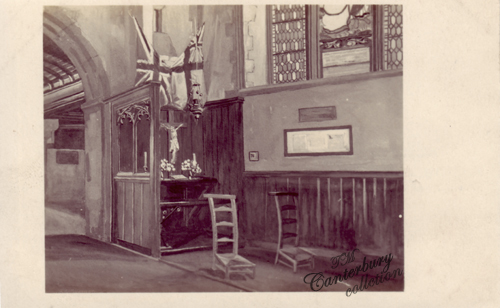
Warriors' Chapel, St. George's Church, Canterbury, Panelled with Teak from H.M.S. Vindictive (from an old postcard in my collection)
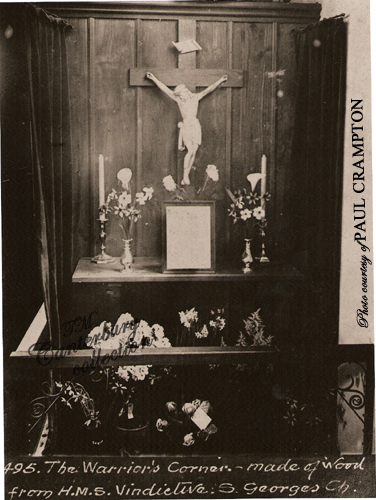
A close-up of the Warrior's Corner and the altar made from wood salvaged from HMS Vindictive
write-up and photo courtesy of Paul Crampton www.paulcramptonbooks.co.uk/
1838
Patrons, The Dean and Chapter of Canterbury
Incumbent & Rector - Frederick ROUCH, Green Court
Churchwardens:
Thomas BOORMAN, Cattle market
Richard Phillip PEARSE, Bridge Street
Parish Clerk, Richard WELLARD, Burgate Street
Sexton, Dan PEARSON, Dover Lane
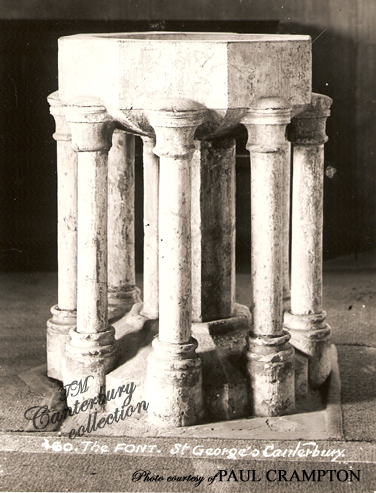
The 13th century font situated at the west end of the central aisle (or the north aisle before the 1872 extension). It was smashed in the blitz.
write-up and photo courtesy of Paul Crampton www.paulcramptonbooks.co.uk/
In "English Church Furniture" by J. Charles Fox 1908 we read
"The 13th century font of St. George's Canterbury is unique; eight tall detatched shafts, with well-moulded capitals and bases, in addition to a larger central shaft, hold up a perfectly plain shallow octagon bowl; the smaller shafts stand out beyond the bowl, which is only supported by half of the capitals. This font is engraved by Rickman." (I'd say it's supported by all the capitals)
John Cooke, A.M. Rector of the united parishes of St. George the Martyr and St. Mary Magdalen, in Canterbury, and of Mersham, in Kent, and one of the six preachers of the Cathedral Church of Canterbury.
"At St. George's Church, Canterbury, Mr. Thomas Partridge to Miss S. Coulson. The singularity of their appearance excited much attraction, the man being about 6 feet 4 inches, and the lady about 4 feet. From their youthful looks, and sprightliness of manners, it was strongly conjectured, that it was a run-away match, particularly as their united ages could not on a moderate calculation, be more than 150 years!." The Literary Panorama 1810
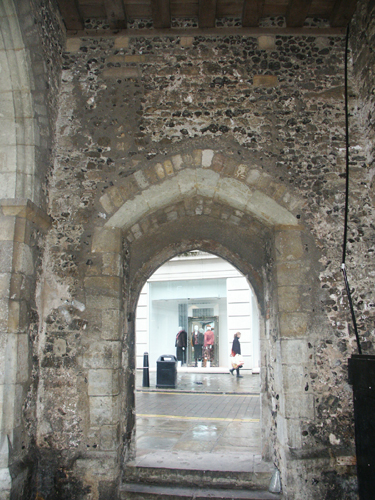
The inside of St. George's Tower, my 2006 photo
"A grand improvement has been made in the interior of St. George's church, Canterbury. A heavy piece of arch-work has been removed, which ran through the entire church from east to west, and not only prevented a very considerable portion of the congregation from seeing the clergyman during the service, but, to a very great degree, from hearing him also." The British Magazine and Monthly Register, 1833
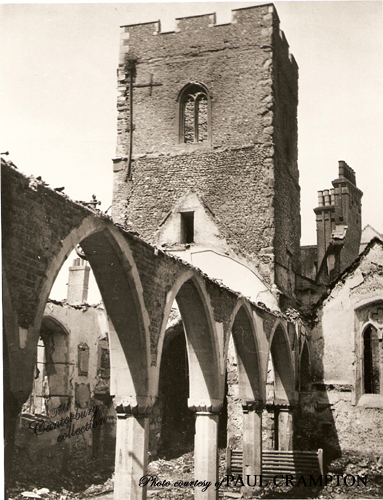 __
__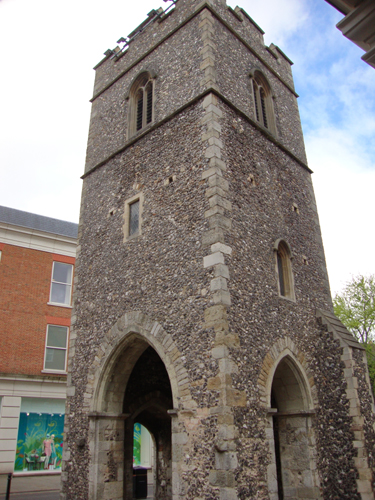
St. George's Church after the
blitz - Another view, probably also 2nd June, looking towards the intact
tower. Note the memorials on the wall (left) and the chimneys of the
White Lion pub (right).
write-up and photo courtesy of Paul Crampton www.paulcramptonbooks.co.uk/
As well as a view of the tower now from that side (2010), you can just see where the roofline was attached to the tower.
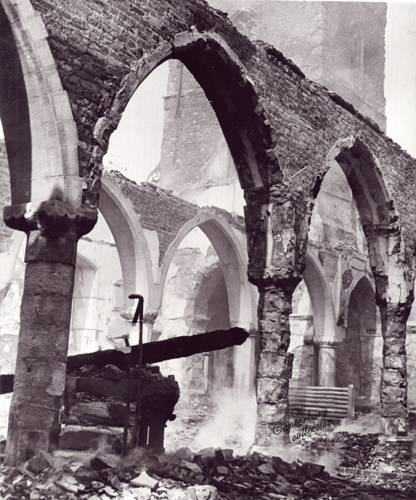
A photo of the bombing of St. George's Church, Canterbury from my collection (possibly showing the font on the left)
"St. George's Church is on the north side of St. George's street, and stands near to where the gate of that name formerly stood. It consists of a nave, north aisle, and a square tower, with a steeple and four bells. An illuminated clock projects into the street. At the west end and over the north aisle are small galleries. The most aged relic in the church appears to be the octagonal font; the bason being upheld by eight small shafts and a small centre one. The living, a rectory valued in the King's books at 7 pounds 17s. 11d. now 140 pounds, became united to St. Mary Magdalen, in 1681; it is in the patronage of the Dean and Chapter of Canterbury." Directory 1847
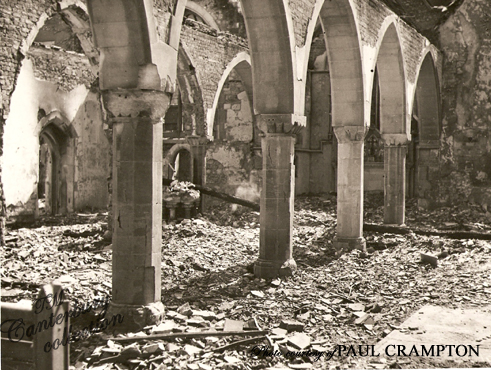
Inside the church looking
east, probably on 2nd June 1942. Note the floor littered with shattered
roof tiles.
write-up and photo courtesy of Paul Crampton www.paulcramptonbooks.co.uk/
"Marriage at St. George's, Canterbury, Arthur, son of John Whitehead, esq., Barngett, Maidstone to Sophie, youngest daughter of the late W. Philpot, esq. of Canterbury." The Gentlemen's Magazine 1858
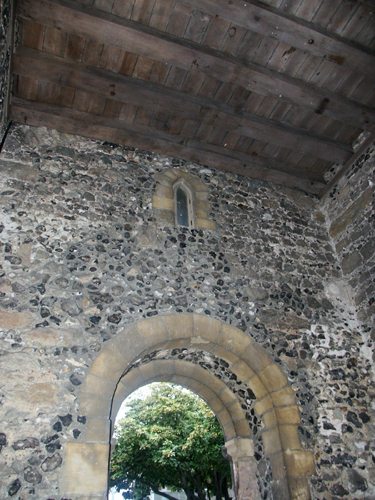
The inside of St. George's Tower, my 2006 photo
"St. George's church is situated on the north side of the High Street, near the gate of the same name; it is a large handsome structure, consisting of two isles and two chancels, having a well built tower steeple, with, till lately, a pointed leaden turret at the northwest corner of it.* There are four bells in the tower and one formerly in the turret.** This church, which is a rectory, was part of the possessions of the priory of Christ Church in Canterbury and at the dissolution of it was granted by Henry VIII. to the dean and chapter of Canterbury, in the patronage of whom, together with that of St. Mary Magdalen, in Burgate, united to it in 1681, it remains at this time.
It appears by the return of the king's commissioners, anno 2 Edward VI. that there were obit lands given by the wills of Edward Parlegate, Thomas Rayley, John Williamson, and Thomas Cadbury, as well for the observation of their obits, as for the maintenance of one lamp in this church for ever.
This rectory is valued in the king's books at 7l. 17s. 11d. and the yearly tenths at 15s. 91/2d. In 1588 it was valued with St. Mary Burgate, at 80l. Communicants three hundred. In 1640 it was valued at only 50l.
Thomas Petit, esq. of St. George's, Canterbury, by his will in 1626, gave 50l. to be disposed of to young married couples for ever, the poorest, as near as might be, of four parishes, one of which should be that wherein he should die, which by the register, appears to have been in this parish of St. George; a more particular account of which is given in the History of Kent, under Chilham.
A terrier of this rectory, dated 1630, is in the consistory court of Canterbury."
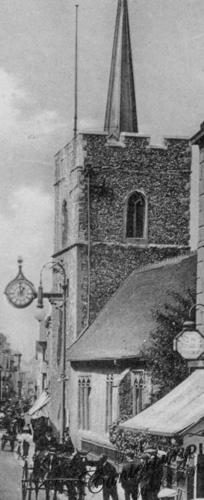 _____
_____
*an arch for the convenience of foot passengers, was cut through the circular, or stair case, part of this tower a few years since, when the city was new paved; but from the many cracks discernible above, it appearing to have done the tower much injury, and that it was becoming dangerous, the commissioners of the pavement of the city, in 1794, ordered it to be taken down and the square tower to be made good, with a pointed spire of wood on the top, at their expense.
**among other monuments and memorials in this church are the following, viz. a monument on the south wall near the altar for Anne, daughter of John Polley, alias Polhill, gent. of Otford, thrice married; first, to Thomas Gilman; secondly to William Nutt of Canterbury, councellor at law; and thirdly, to Thomas Milles, of Davington, obt. 1624; arms, Ermine, a fer de moline, sable, on a chief of the last, two wings conjoined, or, impaling 1st and 4th, argent, on a bend, gules, three crosses potent, or; 2d, argent, an eagle displayed, sable; 3d, sable, a fess between three garbs, or.
A mural monument for Thomas Forster, A.M. rector of this parish and of Chartham, and one of the six preachers of the cathedral, obt. 1764.
A mural monument for Nicholas Knight, gent. late of this parish, obt. 1667; arms, Gules, two bars, ermine, in chief, three griffins heads erased, argent.
A mural monument near the altar, for Edward Randolph, M.D. He had ten sons and five daughters, by Deborah his wife, fourth daughter of Giles Master, esq. of Canterbury, obt. 1681.
Another for John Hobday, gent. and Elizabeth his wife, only daughter of Avery Hilles, esq. a magistrate of this city. They had a numerous issue who are buried here; he died in 1713; she died in 1732; arms, Gules, a fess fusille, argent and azure, between three mullets, pierced of the second; over all an escutcheon of pretence, azure, a chevron between three fleur de lis, argent. On a hatchment for Hills, and inscription for John Hills, gent. obt. 1687.
A mural tablet in the south isle for the Rev. Weyman Bouchery, late rector of Little Blakenham, in Suffolk, obt. 1712; and Elizabeth his wife, daughter of Gilbert Knowler, esq. of Hearne, obt. 1751; and for their daughter Sarah Bouchery, obt. 1783.
A mural tablet for George Bryant, obt. 1787.
In the north isle, on a hatchment, an inscription for John Cotes, gent. of Canterbury, obt. 1655.
On another over the second pillar, an inscription for Thomas Durant, gent. of Canterbury, obt. 1702.
On the pavement under the gallery, a gravestone for Mrs. Field, obt. 1799.
At the east end, on a panel of wood, in a frame, a painting representing Guy Faux, entering the parliament-house; and underneath, IN PERPETUAM PAPISTARUM INFAMIAM. On a small shield; arms, Argent, a chevron between two trefoils, in chief, and a laurel leaf in base, impaling gules, three arrows, or; under the pediment
Caroli Annott
........1632 _______...............
English Fleete......88______Spanish Fleete
under which was a representation of the two fleets, which is now obliterated.
In the middle isle, are several memorials for the Plummers; arms, A chevron, between three griffins heads, erased. A memorial for Elizabeth, relict of Richard Comyns, esq. Sergeant at law, late of Writtle lodge, in Essex, daughter of Tho. Chiffinch esq. of Northfleet, obt. 1764, leaving one daughter; arms, On a lozenge, a chevron, ermine, between three garbs, impaling on a fess embattled, three leopards faces.
In the south isle, on a small white stone in the shape of a heart, Joseph Hasted died an infant, 1769.
On a brass plate with the figure of a priest, an inscription for John Lovelle, rector, obt. 1438.
Memorials for the Boucherys, Greenhills, Caisters, and Banks.
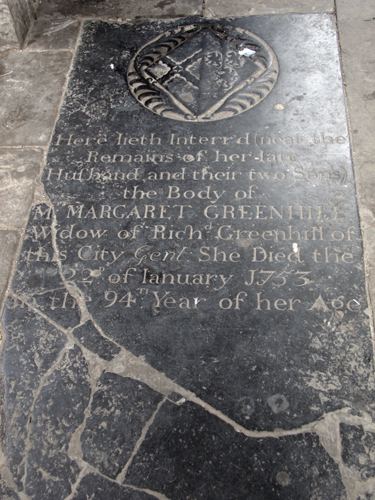
A memorial stone of Margaret Greenhill, wife of Richard Greenhill, which now sits in the floor
of the old St. George's church tower in Canterbury (2010)
There was another memorial for GREENHILL as follows:
"Here lieth interred the body of Mr. Richard Greenhill, who departed
this life March 31, 1706, aged 57 years; his second wife was the
daughter of John Nethersell, gent. by whome he had issue 2 sons, one
dead, and one surviving. HEre lieth the body of Mr. John Greenhill,
son of the abovesaid Richard Greenhill, by his wife Margaret, the
daughter of John Nethersell, gent. He died August 14, 1710, in the
20th year of his age."
A memorial for the Hobday Family
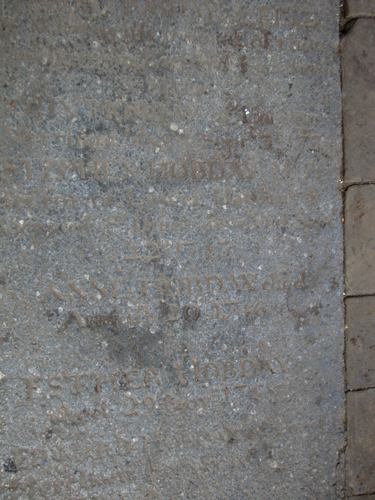
A memorial stone of Stephen Hobday, which now sits in the floor
"Here lieth the body of Mr. John Hobday, and Elizabeth his wife, with seven of their children, viz. Richard, Elizabeth and Mary. John Hobday of London, merchant, died Sep. 3, 1738; Stephen Hobday, M.A. rector of Lower Hardress, and vicar of St. Dunstan's died Sep 22, 1743; Ann Hobday, died August 20, 1746; Esther Hobday, died 29 Nov. 1748; Edward Hobday, merchant, of London, departed this life the 30th of March, 1760."
"Resurgemus" *(we will rise again)
A memorial for Wm Coppin, obt. 1633. Another for Jacob Sharp, obt. 1774; and for the Rev. John Sharp, D.D. rector of St. Mary Abchurch, London, late fellow of C.C.C.C. obt. 1772; and for his mother Elizabeth Sharp, obt. 1780.
A memorial for Thomas Cuntry, late of Ash, obt. 1641; arms, A pile issuing from the chief, between four fleurs de lis, over all a fess.
A memorial for Algerina Dashwood, obt. 1748.
Besides the above there are entries in the register of the burials of the Thornhersts, Masters, and Petyts. The lady Mills in 1634, Courthorpes, Sakers, Wraiths, Hasteds, Barrets, Foches, Hardres's, Sir Peter Gleane, bart. who died an immature death in 1719, and Peter's.
The register begins in the 30th year of king Henry VIII anno 1538, being at first only a copy taken from the old register, as is mentioned in the title of the book. The register itself begins in 1574.
Richard Pargate, a wealthy citizen of Canterbury, who died in 1457, was buried in this church, in the Lady chapel, before the altar, and gave towards the paving of the isle of the church, where his father lay, 20s.
William Tenham, esq. of this parish in 1500 was buried in the same chapel, at the head of Edward Pargate there.
John Rose, alderman, in this church in 1591.
The History and Topographical Survey of the County of Kent, Edward Hasted
Marriage, GILBERT & SNELLER, On the 10th, inst. at St. George's, Canterbury, Harry Pearson GILBERT, M.R.C.S., of West Malling, Kent and younger son of D. Gilbert, of Buckingham Palace Road, London, S.W., to Edith Hill Sneller, third daughter of the late James Vidgen SNELLER (d. 1874) of Canterbury. 1886 The Lancet
|
"The church of
SS. George the Martyr and Mary Magdalene, situated in St. George's
street, was enlarged on the demolition of the church of St. Mary
Magdalene, Burgate, consists of a chancel, nave and aisles, nearly
equal in width and a massive embattled tower at the west end,
surmounted by a slight wooden spire and contains a clock which
was restored in 1877 and two four feet projecting illuminated
dials added by Gillett, Bland & Co. Croydon; this church was
anciently one of the possessions of Christ Church and when that
Monastery was dissolved by Henry VIII., the rectory was transferred
to the Dean and Chapter; the original church consisted of nave
and south aisle and had formerly a steeple extending into the
street, the footpath passing through an arch in the tower; but
this was taken down towards the end of the last century;
in the north wall is a small closed up doorway, which no doubt
formerly gave access to the steeple; the chancel and north aisle
were added in 1871, mainly by the exertions of the Rev. N. H.
McGachen, then rector; the nave and aisles are separated by arcades
of five pointed arches on octagonal pillars with square abaci;
three of the pillars on the north side were brought from the old
church of St. Mary Magdalene; the others are new and have been
executed in facsimile; the tower is supported on Pointed arches
springing from circular shafts'; access to the belfry and clock
chamber being obtained from the west gallery; in the south wall
is a monumental recess and a piscina of early date, the projecting
basin of which has been broken off. There are three stained windows,
one in the chancel, a memorial to Rev. T. Dixon M.A. for 38 years
rector of Holy Trinity, South Shields, Frances, his wife and Jane
Margaret Marianne, their daughter, was erected 25th December,
1881 by the present rector, the Rev. T. F. Dixon and his sister,
in memory of the above, their dear parents and sister; that in
the north aisle is a memorial to the Hon. Mrs. Isaac, 1850; and
that in the south aisle to Mrs. Kingsford, 1841; in the south
aisle are two sedilia of Decorated work and an ancient door now
blocked up, probably a priests door. In the floor of the nave
is a well-preserved brass, with effigy to John Lovelle, a former
rector of this church, 1438. The font is a very good Early English
one, octagonal in form, and supported on a central pedestal, with
seven surrounding shafts. In the vestry is a painting on panel,
representing Guy Fawkes entering the Parliament House, dated 1632
and inscribed, "In perpetuam Papistarum infamiam." The
church has two projecting illuminated clock dials, repaired in
1877; there are sittings for 500 persons all free. The registers
date respectively from 1538 and 1664. The registers of St. George
the Martyr date from 1538; the portion between that date and 1574
being a copy from some pre-existing book; those of St. Mary Magdalene
date from 1664 only. St. George the Martyr and St. Mary Magdalene
form a joint rectory net yearly value 80 pounds, with residence
in the patronage of the Dean and Chapter of Canterbury and held
since 1881 by the Rev. Thomas Featherston Dixon, M.A. of Christ's
College, Cambridge."
From Kelly's 1882 directory of Kent "The Kentish Gazette of August 8th, 1794" The workmen on Monday began to throw down the ancient round tower attached to the South-east corner of the steeple of St. George's church at Canterbury. It contained a flight of stone steps to its top crowned with a spire and handsome weather cock, useful and ornamental to the city; but, in consequence of the new pavement in 1788, an arched passage was opened through its bottom for foot passengers, which was supposed to have weakened the body so much that it was judged necessary to be removed." Is there not reason to conclude that there might be want of skill in the surveyor employed to turn the arch? for was not the experiment made with success under the tower of the much more lofty steeple of the church of St. Magnus, near London Bridge? Or, is there not a tradition that Sir Christopher Wren, who built the latter, some time after the church was rebuilt, foreseeing that a passage might be wanted under it, provided for it by turning arches, which he filled up till the time for opening them arrived. D.H. |
St. George's Steeple 1794...A committee survey St. George's steeple, and report it to be in a dangerous state; in consequence of which it is soon afterwards taken down. Monday, August 4th, 1794. The workmen began to take down the ancient round tower attached to the S.E. corner of the steeple of St. George's church, in Canterbury. It contained a flight of stone steps to its top, crowned with a spire and handsome weathercock, useful and ornamental to the city; but in consequence of the new pavement, in 1788 an arched passage was opened through its bottom for foot passengers; which was supposed to have weakened the building so much, that it was judged necessary to be removed. |
In 1788, when the city was new paved, the stair-case to the tower of this church, which projected some distance into the street beyond the line of the adjoining buildings, was perforated, and a footway continued through it; but in 1794, this building, which supported a flight of stone steps with a spire and weather cock on top, was declared to be unsound; it was in consequence taken down, and a spire of wood and a weather-cock placed upon the tower itself. William Gostling
August 13, 1870 - St. George's Church, Canterbury. The legal notice that a faculty has been applied for to close St. Mary Magdalen Church, and enlarge that of St. George the Martyr, has been affixed to the church doors in Canterbury. It is proposed to take down Burgate Church, excepting the tower, in which will be preserved the monuments now in the church. The organ, bells, and fittings of the church will be sold, and the proceeds given to the fund for enlarging St. George's Church. A part of the St. George's rectory-house will have to be pulled down to make room for the new aisle. The Architect
"Proceeding..., and here on the left-hand side will be noticed the church of St. George, which stands close to the site of the old gateway of that name. There is a Norman west doorway under the tower. The tower, which is at the west end of the south aisle, is probably chiefly Norman; it is unbuttressed. There is some interesting late fourteenth-century work at the east end of the south isle. The most noteworthy feature of this church is the font at the east end of the nave, which is of unique arrangement. The bowl, which is a shallow octagon, rests on seven slender shafts, the flat capitals of which project some little way beyond the bowl that they support. It is of 13th century date, and has a plain domed cover of the 17th century. A brass plate at the west end of the north aisle states that the church of St. George the Martyr was enlarged, by the addition of a north aisle and chancel, for the joint accommodation of the parishioners of St. George's and St. Mary Magdalene's, in 1872. The body of the church of St. Mary Magdalene was at that time pulled down, and the arcade between the north aisle and nave of this church is mainly removed from that fabric."
Canterbury, a history of the ancient city - written by J. Charles Cox, LLD., F.S.A. - 1905
1762 - Jan 7th, Mary TERRY
Dec 4, Elizabeth TERRY
baptism of s Sarah, daughter of Isaac and Sarah TERRY (date?)
death? - Mary, wife of Michael TERRY (date?)
Marriage of Thomas RALPH to Sarah TERRY at St. George's - Nov 5, 1815
1777 - 1824 - Rev. James Ford. "Death Jan 5th. at his residence in the Precincts, Canterbury, and in his 74th year, the Rev. James Ford. This highly respectable divine was a native of the county of Gloucester, and received the early part of his education at the College School in that city from whence he was removed to Magdalen College, Oxford, where he proceeded to the degree of B.A. in 1772. In 1774 he was ordained a Deacon by Dr. Louth, the then Bishop of Oxford: and in 1776, a Priest, by Dr. Egerton, Bishop of Durham. In 1775 he was elected a Minor Canon of the Collegiate Church of Durham, and which he resigned in 1777, on his appointment to the same situation in the Cathedral of Christ Church, Canterbury; and in the same year was presented by the Dean and Chapter to the Rectories of St. George the Martyr and of St. Mary Magdalene, in that city. He married Dorothy the third daughter of William Spearman, of Durham, esq. of a very antient and highly respectable family in that county (an account of which, together with their several pedigrees, is inserted in Surtees's eleborate History of that County), and by whom he has left issue four sons and two daughters. After a conscientious discharge of the respective duties of his situation for the long period of forty-seven years, he departed this life on the 5th, and was interred in the cloisters of Canterbury Cathedral." The Gentlemens Magazine 1824
John Cooke, A.M.
1828 - Ecclesiastical Preferments - Rev. G. Pellew, St. George R. with St. Mary Magdalen, Canterbury
1840 - Preferments, Rev. W. S. H. Braham, M.A., to the Rectories of St. George and St. Mary Magdalen, Canterbury
1846 - Rev. W. S. H. Braham, M.A.
1847 - Rev. William Spencer Harris Braham
1853 - Rev. James Ford
"Death - Mary, eldest daughter of the late Rev. James Ford, Rector of St. George the Martyr and St. Mary Magdalene, Canterbury." The Gentlemen's Magazine 1853
(date?) John Cooke, A.M., "Thrity-nine Sermons, by (a late very celebrated preacher) John Cooke, A.M., Rector of the united parishes of St. George the Martyr and St. Mary Magdalen in Canterbury, and of Mersham in Kent, and one of the Six Preachers of the Cathedral Church of Canterbury." The book had been printed by Cave some years before; see a very full advertisement of it in Gent. Mag., vol. i. p. 548
1858 - Rev. R.G. Peter
November 22, 1859 - Death at his residence, St. George's place, Canterbury, Major Wm. Ford., R.M. Light Infantry, second son of the late Rev. James Ford, Rector of St. George the Martyr and St. Mary Magdalen, in that city. GM
1871- Rev. N. H. McGachen, rector
1881, 1882 - Thomas Featherston Dixon M.A. hours of service 11 am, 6:30 pm Wed 11:00 am, Fri 11:00 am
1889 - Rev. Henry Day French M.A.
1889 - Isaac Goby, sexton at St. George's Church
1900-1903 Rev. Francis Thomas Vine M.A. (Magdalene College, Cambridge), Hours of Service: 8 & 11:00 am. & 6:30 pm. wed. & fri. 11:00 am. ; Saints days 7:30 am.
1917 - Rector, Rev. B. B. Smith; Churchwardens, Mr. J. Partridge and Mr. H. Dowding
Mr. Butler has a photograph of the inside of St. George's Church (pg 72) in his book entitled "Canterbury in old photographs" Published 1989 by Budding Books, ISBN 1-84015-037-8
Index of Wills
Edmond RANDOLPH, doctor in phisicke, St. George the Martyr, Canterbury, Kent 1654, folio 100
